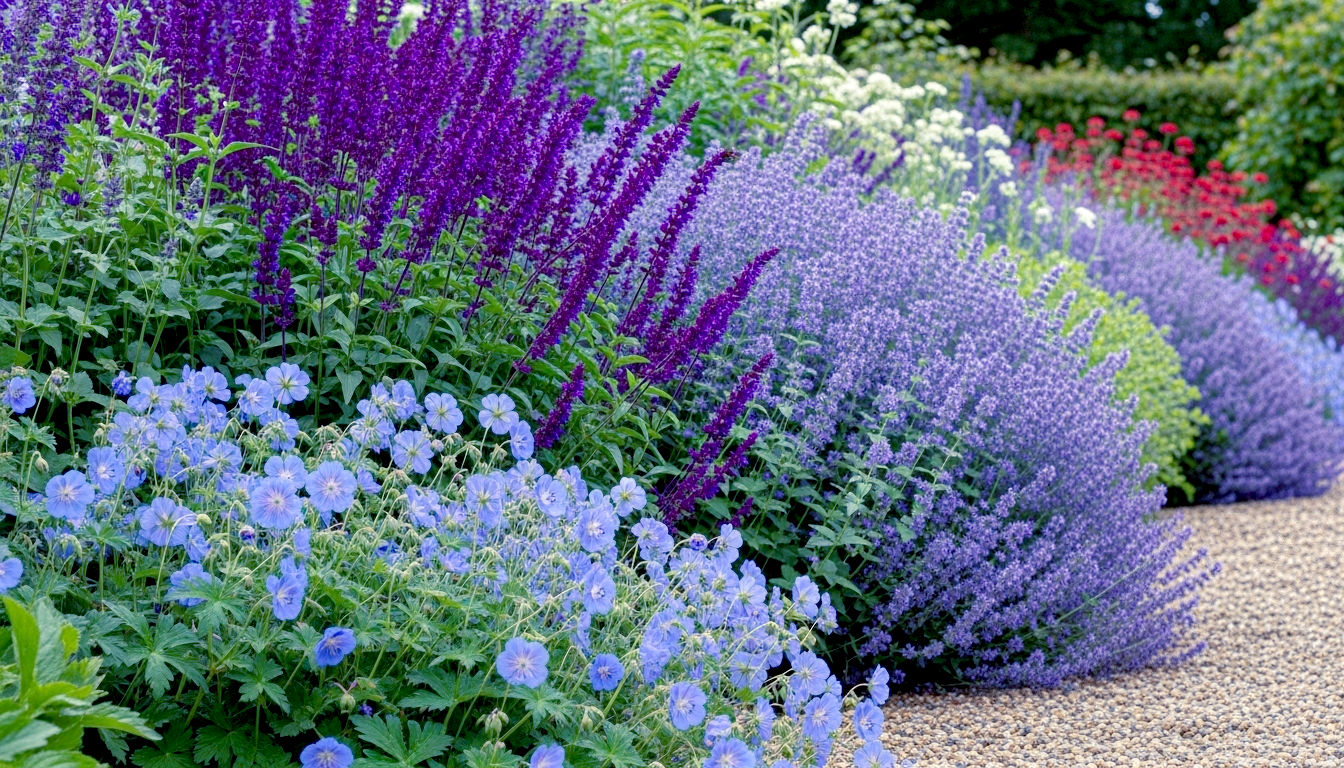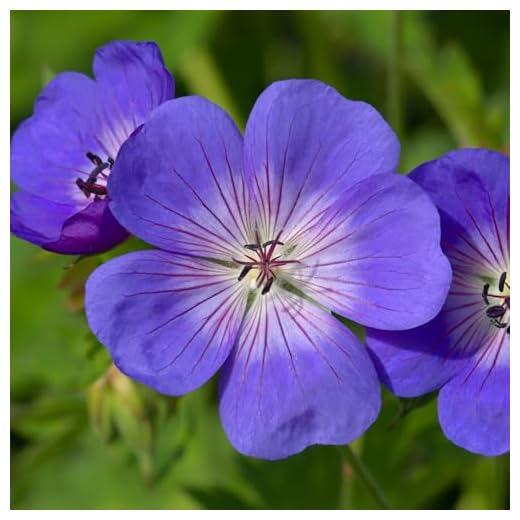Perennial Power: Your Guide to a Garden That Blooms Year After Year
Your definitive guide to creating a beautiful British garden with perennials. We reveal the top 5 foolproof plants and all the secrets to make them thrive.

This post may contain affiliate links. If you make a purchase through these links, we may earn a commission at no additional cost to you.
Picture this: it’s a bright Saturday morning in May. You’ve got a cup of tea in hand, and you’re looking out at your garden. But instead of seeing bare patches of earth that need filling (again), you see a border buzzing with life. Green shoots are pushing up, promising a summer of colour, and some early flowers are already putting on a show for the bees. Best of all? You didn’t have to replant most of them. They just… came back.
This isn’t a gardening fantasy. This is the magic of perennials.
If you’ve ever felt that gardening is a bit of a treadmill—buying expensive bedding plants every spring only to see them disappear by winter—then this guide is for you. We’re going to pull back the curtain on the plants that form the backbone of the most beautiful British gardens, from grand country estates to tiny city patios. These are the reliable, returning friends of the plant world.
Think of perennials as a smart investment. You buy them once, and with a bit of simple care, they’ll reward you with more flowers, more structure, and more life for years to come. They’re better for your wallet, brilliant for our bees and butterflies, and, honestly, much less faff in the long run.
So, grab another cuppa. We’re about to explore everything you need to know to build a stunning garden with five of the very best, most foolproof perennials you can grow in the UK.
What on Earth is a Perennial, Anyway?
Right, let’s get the main question out of the way. The word “perennial” sounds a bit fancy, but the idea behind it is incredibly simple.
The Simple Definition: Plants with Staying Power
In the plant world, you’ve basically got three types of life cycles:
- Annuals: These are the ‘live fast, die young’ crowd. They do everything in one year—sprout, flower, make seeds, and then they’re done for. Think of summer bedding like petunias or marigolds. They’re a summer fling.
- Biennials: These take two years to complete their cycle. In the first year, they grow leaves. In the second, they flower, set seed, and then pop their clogs. Foxgloves and Sweet William are classic examples.
- Perennials: These are the keepers. A perennial is simply a plant that lives for more than two years. They’re in it for the long haul. They come back season after season, often getting bigger and better with each passing year.
So, when you plant a perennial, you’re planting a long-term relationship, not just a splash of temporary colour.
Herbaceous vs. Evergreen: Now You See It, Now You Don’t
You’ll often hear perennials described as either “herbaceous” or “evergreen.” Don’t let the jargon put you off—it’s an easy distinction.
- Herbaceous Perennials: This is the most common type. These plants die back to the ground when the first frosts of autumn arrive. They look like they’ve disappeared completely over winter, but don’t panic! Their roots are alive and well underground, snoozing away, ready to send up fresh new growth the following spring. Hostas, delphiniums, and most daisies are herbaceous.
- Evergreen Perennials: Just like evergreen trees, these plants keep their leaves all year round. They provide valuable structure and colour in the garden during the bleak winter months. Many grasses, Heucheras (Coral Bells), and some ferns are evergreen perennials.
Sleep, Creep, Leap: The Three-Year Rule
There’s a handy old saying among gardeners that perfectly describes how a new perennial settles in:
- Year 1: Sleep. The first year you plant it, the perennial is busy growing its roots underground. You’ll see some growth and maybe a few flowers, but it’s mostly focused on getting established. It’s sleeping.
- Year 2: Creep. In its second year, you’ll see more growth above ground. The plant is bigger, healthier, and will produce more flowers. It’s creeping.
- Year 3: Leap. This is the year the magic happens. Now fully established, your perennial will leap into action. It will be a glorious, full-sized plant, flowering its socks off.
This is a great rule to remember. It teaches patience and stops you from thinking you’ve done something wrong if your brand-new plant isn’t a showstopper in its first summer.
Why Perennials are Perfect for UK Gardens
So why are we making such a big fuss about these plants? Because they are, without a doubt, the most rewarding plants you can grow, especially in our unique British climate.
More Blooms for Your Buck
Let’s be honest, gardening can be an expensive hobby. A tray of six annual bedding plants can cost a fiver, and you have to buy them every single year. A perennial might cost £8-£15 for a single plant, which seems like more at first. But that one plant will come back for five, ten, or even twenty years. Even better, after a few years, you can often divide a big clump into smaller pieces, giving you new plants for free! Over time, perennials offer incredible value for money.
A Haven for British Wildlife
Our native pollinators—bees, hoverflies, butterflies—are having a tough time. Perennial-rich gardens are like a 24/7 Michelin-starred restaurant for them. Because different perennials flower at different times, you can create a food source that lasts from early spring right through to late autumn. The open, simple flower shapes of many perennials are perfect for pollinators to access nectar and pollen. Plus, leaving the seed heads on over winter provides food for birds like goldfinches and shelter for insects.
The Backbone of Your Borders
Annuals are great for a quick splash of colour, but they don’t provide much structure. Perennials do. They form the permanent framework of your garden beds, or “borders.” Their varied shapes, heights, and textures—from tall, spiky salvias to soft, rounded geraniums—create interest even when they’re not in flower. They are the ‘good bones’ of your garden design.
A Garden for All Seasons
A well-planned perennial border is never boring. It’s a slow-motion show that changes every week. You get the excitement of seeing the first green shoots poke through in spring. Then the crescendo of colour in summer. This is followed by the rich, warm tones of autumn. And even in winter, the frosted seed heads of plants like Rudbeckia can look absolutely magical. It’s a garden that truly lives and breathes with the seasons.
Before You Plant: A Five-Minute Guide to Garden Success
Before you rush off to the garden centre, a little bit of planning will pay off massively. You don’t need a degree in horticulture, just a few minutes of observation.
Golden Rule: Right Plant, Right Place
This is the most important rule in gardening. It means matching a plant to the conditions it loves. A sun-loving plant will sulk in the shade, and a plant that likes dry feet will rot in a boggy patch. By choosing plants that naturally suit your garden’s environment, you’re setting them up for success and making your life much, much easier.
Get to Know Your Soil (Without a Science Degree)
You don’t need a fancy kit. Just grab a handful of your garden soil when it’s damp (but not soaking wet).
- Squeeze it: Does it feel gritty and fall apart easily? You’ve likely got sandy soil. It drains quickly and doesn’t hold onto nutrients well.
- Squeeze it: Does it feel silky and mould into a ball, but still crumbles? You’ve hit the jackpot with loamy soil. It’s the perfect balance of drainage and water retention.
- Squeeze it: Does it feel sticky and form a solid, shiny sausage shape? That’s clay soil. It’s rich in nutrients but can be heavy and waterlogged in winter and bake solid in summer.
Most plants will be happy in loam, but don’t worry if you have sand or clay. There are plenty of fantastic perennials that will thrive in both—you just need to choose the right ones.
Follow the Sun: Mapping Your Garden’s Light
Spend a day noticing where the sun falls in your garden. Make a quick sketch and label the different areas:
- Full Sun: Gets at least 6 hours of direct sun a day, especially in the middle of the day.
- Partial Shade (or Semi-Shade): Gets 3-6 hours of sun, often in the morning or evening. This is a very useful type of light that many perennials love.
- Full Shade: Gets less than 3 hours of direct sun a day. This can be the trickiest spot, but there are still beautiful perennials that will grow here.
Knowing your sun spots is crucial for putting the right plant in the right place.
Designing Like a Pro: Simple Tricks for Stunning Borders
You don’t need to be a famous garden designer to create a beautiful border. Just follow a few simple tips:
- Go Big at the Back: Put your tallest plants at the back of the border, medium-sized ones in the middle, and the shortest ones at the front. It sounds obvious, but it makes a huge difference.
- Plant in Drifts: Avoid planting single plants like lonely soldiers. Instead, plant in groups or “drifts” of three, five, or seven. Using odd numbers looks more natural and less formal to the eye.
- Repeat, Repeat, Repeat: Choose a few key plants and repeat them along the length of the border. This creates a sense of rhythm and unity, tying the whole design together.
The Ultimate Starter Kit: 5 Perennials to Boost Your Garden
Okay, it’s time to meet the stars of the show. We’ve chosen five incredible perennials that are tough, beautiful, long-flowering, and perfect for anyone starting out. They are all widely available in UK garden centres and have the prestigious RHS Award of Garden Merit (AGM), which means they are certified as reliable performers.
1. The Marathon Runner: Geranium ‘Rozanne’
If you could only grow one perennial, it would probably be this one. Geranium ‘Rozanne’ (also known as Cranesbill) is a horticultural superstar. It’s not to be confused with the bright red “geraniums” you see in pots and hanging baskets, which are actually Pelargoniums. This is a true, hardy geranium, and it is simply unbeatable.

Profile: The Unbeatable Blue Bloomer
- Why it’s a star: It flowers its heart out. And we mean it. ‘Rozanne’ starts flowering in late May or early June and will continue, non-stop, until the first hard frosts in October or even November. No other perennial comes close to this flowering period. It’s also incredibly tough and forgiving.
- Good for: Filling gaps at the front of borders, spilling over paths, weaving through other plants, growing in pots.
- Wildlife: An absolute magnet for bees.
In the Garden: What it Looks Like
‘Rozanne’ has beautiful, saucer-shaped flowers of a stunning violet-blue with a clear white eye. They are held above a lush mound of pretty, deeply-cut, marbled green leaves. It’s a sprawling, relaxed plant, not an upright one. It forms a clump about 30cm (1ft) high but can spread outwards to about 60-90cm (2-3ft), cleverly filling gaps and suppressing weeds as it goes. In autumn, the foliage often turns fiery shades of red and orange, giving you one last hurrah before winter.
How to Grow ‘Rozanne’: Your Cheat Sheet
- Sun/Shade: Happy in full sun or partial shade. It will produce the most flowers in a sunny spot.
- Soil: It’s not fussy at all. It will grow in almost any soil, from clay to sand, as long as it isn’t permanently waterlogged.
- Hardiness: It’s fully hardy in all parts of the UK (RHS rating H7), so you don’t need to worry about protecting it in winter.
Year-Round Care Plan
- Planting: Plant it in spring or autumn. Dig a hole twice the width of the pot, add a handful of compost, and plant it at the same depth it was in its pot. Water it well.
- Spring: As new growth appears, give it a feed with a general-purpose fertiliser like Growmore or fish, blood, and bone.
- Summer: This is the clever bit. Around mid-summer (July/August), the plant can start to look a bit tired and leggy. If this happens, give it the “Hampton Hack”—named after the RHS Hampton Court Palace Garden Festival. Simply cut the whole plant back to the ground. It looks drastic, but within two weeks it will have produced a fresh mound of leaves and will start flowering again, looking pristine right through to autumn.
- Autumn/Winter: Once the frosts have blackened the leaves, you can just cut the old foliage back to the base. It’s that simple.
Perfect Partners
‘Rozanne’ is a brilliant team player. Its sprawling habit is perfect for softening the base of taller, more upright plants. It looks fantastic weaving through the silver leaves of Nepeta (Catmint) or popping up amongst the stems of pink or white roses.
2. The Architectural Star: Salvia nemorosa ‘Caradonna’
Every garden needs some exclamation marks—plants that provide strong, upright shapes. And they don’t come much better than Salvia ‘Caradonna’. This plant adds a touch of class and sophistication to any planting scheme with its intense colour and striking form.

Profile: The Striking Violet Spire
- Why it’s a star: ‘Caradonna’ has an incredible colour. The flowers are a rich, deep violet-blue, but what makes it really special are the stems, which are an almost-black purple. This gives the whole plant a dramatic, moody look. It flowers for a long time and, if you give it a chop, it will reward you with a second flush.
- Good for: Adding vertical interest, creating a “see-through” effect in borders, cottage gardens, modern gravel gardens.
- Wildlife: A favourite of bees and butterflies.
In the Garden: What it Looks Like
‘Caradonna’ forms a neat clump of slightly wrinkled, grey-green leaves. From this base, it sends up dozens of slender, upright, dark purple stems to a height of about 60cm (2ft). These stems are crowded with tiny, intensely coloured flowers from June to July. Even after the flowers have faded, the dark stems hold their structure and colour, looking good for weeks afterwards.
How to Grow ‘Caradonna’: Your Cheat Sheet
- Sun/Shade: This is a sun-worshipper. It needs full sun to perform at its best and to keep its stems strong.
- Soil: The most important thing for salvias is good drainage. They hate sitting in wet soil, especially in winter. It will be happy in average or even poor soil. If you have heavy clay, add some grit to the planting hole to help drainage.
- Hardiness: It’s very hardy across the UK (RHS H7) as long as the soil isn’t waterlogged.
Year-Round Care Plan
- Planting: Plant in spring to give it a full season to get its roots down before winter.
- Spring: Wait until the new growth is well underway before cutting back the old, dead stems from last year.
- Summer: This is key for a long flowering season. As soon as the first main flush of flowers starts to fade (usually in late July), cut the flowering stems right back to the base of the plant. Give it a good water and a liquid feed (like tomato food). Within a few weeks, it will send up a whole new set of flowering stems that will see you through to autumn.
- Autumn/Winter: Do not cut the old stems back in autumn. Leave them standing over winter. This provides some protection for the crown (the centre) of the plant from winter wet and frost.
Perfect Partners
The strong vertical shape of ‘Caradonna’ contrasts brilliantly with softer, mound-forming plants. It looks amazing next to the fluffy lime-green flowers of Alchemilla mollis (Lady’s Mantle) or surrounded by the silvery foliage of Artemisia ‘Powis Castle’. For a real designer look, plant it in big drifts through ornamental grasses like Stipa tenuissima.
3. The Autumn Sunbeam: Rudbeckia fulgida var. sullivantii ‘Goldsturm’
Just when you think the summer show is starting to wind down, ‘Goldsturm’ bursts onto the scene. This plant, commonly known as Black-Eyed Susan, is the undisputed star of the late summer and autumn garden, bringing a welcome blast of sunshine when you need it most.

Profile: Sunshine on a Stem
- Why it’s a star: It’s incredibly reliable and long-lived. It flowers for months, from August right through to October, and its cheerful, daisy-like flowers are impossible to dislike. It’s also sturdy and stands up well to wind and rain, so it rarely needs staking.
- Good for: Late summer colour, prairie-style planting, providing winter interest.
- Wildlife: The flowers are good for late-season pollinators, and birds love the seeds in winter.
In the Garden: What it Looks Like
‘Goldsturm’ produces a sea of golden-yellow, daisy-like flowers, each with a prominent, dark brown central cone (the ‘black eye’). The flowers are held on strong, branching stems about 60-75cm (2-2.5ft) tall, above a clump of dark green leaves. It’s a fantastic plant for creating a bold splash of colour. When the petals drop, the dark cones remain, looking like little sculptures when dusted with frost in winter.
How to Grow ‘Goldsturm’: Your Cheat Sheet
- Sun/Shade: It loves sun but will tolerate a little light shade for part of the day.
- Soil: It prefers a reasonably moist but well-drained soil. It doesn’t like to dry out completely in summer, but it also dislikes sitting in water in winter. Average garden soil is usually perfect.
- Hardiness: Fully hardy throughout the UK (RHS H6).
Year-Round Care Plan
- Planting: Spring or autumn is the best time.
- Spring: Give it a good mulch with garden compost to feed the soil and lock in moisture for the summer ahead.
- Summer: Water during any prolonged dry spells, especially in its first year.
- Autumn/Winter: Resist the urge to tidy up! Leave the seed heads standing all winter. They provide crucial food for birds like goldfinches and look wonderful covered in frost. You can cut the dead stems down to the ground in late winter or early spring, just before the new growth starts.
- Dividing: After 3-4 years, the clump may get congested and flower less. This is a sign it’s time to divide it in spring to create new plants.
Perfect Partners
The golden-yellow of ‘Goldsturm’ is a classic autumn combination with purple. It looks absolutely stunning planted next to Asters (now called Symphyotrichum) or the tall, airy purple flowers of Verbena bonariensis. For a modern look, plant it in large blocks surrounded by ornamental grasses, which will echo its prairie origins.
4. The Pollinators’ Pub: Nepeta ‘Six Hills Giant’
If you want your garden to be buzzing with life, plant Catmint. And ‘Six Hills Giant’ is the king of the Catmints. It’s a tough, drought-tolerant, and beautiful plant that forms a soft, billowing cloud of lavender-blue for weeks on end. It’s a brilliant alternative to Lavender, especially if you have heavier clay soil where Lavender can struggle.

Profile: The Soft, Billowing Cloud
- Why it’s a star: It is one of the best plants in the world for attracting bees. On a sunny day, it will literally be humming with them. It has a wonderfully long flowering season and is very low-maintenance. The foliage is aromatic too—crush a leaf, and it releases a minty, slightly spicy scent.
- Good for: Edging paths, softening borders, cottage gardens, dry and sunny banks. And yes, cats do love it!
- Wildlife: Off-the-charts amazing for bees.
In the Garden: What it Looks Like
‘Six Hills Giant’ forms a sprawling mound of soft, grey-green, heart-shaped leaves. From early summer, it’s covered in a haze of small, lavender-blue flowers on upright spikes, reaching a height of about 75-90cm (2.5-3ft). It has a very relaxed, informal feel and is perfect for spilling over the edge of a path or wall.
How to Grow ‘Six Hills Giant’: Your Cheat Sheet
- Sun/Shade: Full sun is a must. It needs the sun to produce the best flowers and the strongest scent.
- Soil: It needs well-drained soil. It’s very drought-tolerant once it’s established and is a great choice for sandy soils or gravel gardens. It will grow in clay as long as it doesn’t get waterlogged in winter.
- Hardiness: Very hardy across the UK (RHS H7).
Year-Round Care Plan
- Planting: Plant in spring.
- Spring: Wait until new growth appears at the base, then cut back all of last year’s dead stems.
- Summer: Just like the Salvia, Nepeta benefits massively from a haircut. After its first big flush of flowers is over (usually in July), shear the whole plant back by about half. This will encourage a fresh flush of leaves and a second wave of flowers that will last into the autumn. This also stops the plant from flopping open in the centre, which it can sometimes do after heavy rain.
- Autumn/Winter: Leave the old stems on over winter for a bit of structure and then cut them back in spring.
Perfect Partners
The soft texture and cool blue colour of Nepeta are the perfect foil for plants with strong colours or shapes. It looks beautiful at the foot of shrub roses, especially those with pink or deep red flowers. It’s also a classic companion for the silvery leaves of Stachys byzantina (Lamb’s Ears).
5. The Elegant Finisher: Anemone x hybrida ‘Honorine Jobert’
Just as the Rudbeckia is bringing the sunshine, ‘Honorine Jobert’ brings a touch of pure, simple elegance to the autumn garden. This Japanese Anemone is one of those graceful, effortless-looking plants that can light up a shady corner when little else is flowering.

Profile: The Graceful Autumn Dancer
- Why it’s a star: It produces its beautiful flowers late in the season, from late August to October, providing colour when many other plants are fading. It thrives in that tricky partial shade condition that many gardens have. Its tall, wiry stems mean the flowers seem to float and dance in the breeze.
- Good for: Lighting up shady corners, woodland-style gardens, providing late-season pollen for insects.
- Wildlife: A good late source of food for pollinators.
In the Garden: What it Looks Like
‘Honorine Jobert’ has large, single, bowl-shaped flowers of the purest white, with a boss of golden-yellow stamens in the centre. They are held high on slender, branching stems that can reach up to 1.2m (4ft). The leaves form a handsome clump of dark green, vine-like foliage at the base. The whole effect is wonderfully graceful and airy.
How to Grow ‘Honorine Jobert’: Your Cheat Sheet
- Sun/Shade: This is its superpower. It is happiest in partial shade, perhaps with morning sun and afternoon shade. It can tolerate more sun if the soil is consistently moist, and more shade if the soil is drier.
- Soil: It loves a rich, moist but well-drained soil. It really appreciates having compost or leaf mould dug in when planting.
- Hardiness: Fully hardy across the UK (RHS H7).
- A Word of Warning: Japanese Anemones can be thugs in the right conditions! They spread by underground runners. This can be great if you have a large area to fill, but in a small, neat border, they can become a nuisance. Plant them where they have room to roam or be prepared to dig out unwanted shoots each spring.
Year-Round Care Plan
- Planting: They are best planted in spring. They can be slow to establish, so be patient.
- Spring: Apply a generous mulch of garden compost around the base of the plant to feed it and conserve moisture.
- Summer: Water during dry spells.
- Autumn/Winter: You can cut the stems down after flowering, or leave them for winter interest. The seed heads look like little balls of cotton wool.
Perfect Partners
The tall, airy nature of ‘Honorine Jobert’ looks wonderful rising up through lower-growing, shade-tolerant plants. It’s a classic partner for Hostas and Ferns, whose bold foliage provides a perfect contrast to the delicate flowers. It also looks beautiful planted behind the silvery leaves of Brunnera ‘Jack Frost’.
Your Perennial Masterclass: Planting and Long-Term Care
You’ve chosen your plants. Now for the fun part: getting them in the ground and looking after them. Don’t worry, it’s easy.
Getting Your Hands Dirty: A Step-by-Step Planting Guide
- Soak the Plant: Before you do anything, give your new plant a good drink. Submerge the pot in a bucket of water for about 10 minutes until no more air bubbles come out.
- Dig a Good Hole: Dig a hole that is roughly twice as wide as the pot and about the same depth. This gives the roots plenty of loosened soil to grow into.
- Improve the Soil: Pop a spadeful of garden compost, well-rotted manure, or a peat-free multi-purpose compost into the bottom of the hole and mix it in. This is like packing a lunchbox for your new plant.
- Remove from the Pot: Gently squeeze the pot and turn the plant upside down, supporting the top with your other hand. It should slide out easily.
- Tease the Roots: If the roots are tightly wound in a spiral, gently tease out the ones at the bottom with your fingers. This encourages them to grow outwards into the soil.
- Plant and Backfill: Place the plant in the hole so that the top of its rootball is level with the surrounding soil. Fill the hole back in with the soil you dug out, gently firming it down with your hands to get rid of any air pockets.
- Water In Well: Give the plant a really good watering. This settles the soil around the roots and is the most important drink it will ever have.
The “Chelsea Chop”: A Haircut for Healthier Plants
This sounds scary, but it’s a brilliant technique for many mid- to late-summer flowering perennials like Sedums (now Hylotelephium), Phlox, and Asters. It’s named after the RHS Chelsea Flower Show because you do it in late May.
You simply cut the stems back by about a third or a half. What does this achieve?
- It makes the plant shorter and sturdier, so it’s less likely to need staking.
- It delays flowering by a couple of weeks, which can be useful.
- It encourages the plant to produce more side shoots, which means you get more, smaller flowers for a longer period.
You can be brave and chop the whole plant, or you can try chopping just the stems at the front of the clump to create a nice tiered effect.
Deadheading, Staking, and Feeding: The Essentials
- Deadheading: This just means removing the faded flowers. On plants like Salvia and Geraniums, cutting back spent flower stems encourages the plant to produce more flowers instead of putting its energy into making seeds. On plants like Rudbeckia, you might choose to leave the seed heads for the birds.
- Staking: Some tall perennials like Delphiniums or those in windy spots will need a bit of support. The trick is to get the support in early, before the plant needs it, so it can grow up through it naturally. You can use bamboo canes and string, metal link stakes, or even twiggy branches (often called pea sticks) for a rustic look.
- Feeding: Most perennials are not greedy feeders. A yearly mulch in spring with good garden compost is usually all they need. This feeds the soil, which in turn feeds the plant. It also helps to keep weeds down and moisture in.
The Gardener’s Best Kept Secret: Making More Plants for Free
After a few years, you might notice the centre of a perennial clump dying out, or the plant might just be getting too big for its space. This is the time to divide it. It’s an easy way to get lots of new plants for free and to rejuvenate the original clump.
The best time to do it is either in autumn or spring. Simply dig up the whole clump, shake off some of the soil, and then split it into smaller sections using two forks back-to-back as levers, a spade, or even an old bread knife. Make sure each new piece has some healthy roots and some shoots. Replant the new sections wherever you want them and water them well.
What Next? Exploring the Wonderful World of Perennials
Our ‘Fab Five’ are a brilliant starting point, but they are just the beginning. Once you get the bug, there’s a whole world of perennials to discover.
Top Picks for Tricky Spots
- For Dry Shade: Epimedium (Barrenwort), Liriope muscari (Lilyturf), Geranium phaeum (Dusky Cranesbill).
- For Damp Shade: Hosta (be wary of slugs!), Astrantia (Masterwort), Rodgersia.
- For Hot, Dry Sun: Eryngium (Sea Holly), Achillea (Yarrow), Sedum (Hylotelephium).
Don’t Forget the Grasses!
Ornamental grasses are perennials too, and they are essential for bringing movement, texture, and a modern feel to a border. They look good for months on end and contrast beautifully with flowering perennials. Try the feather-like Stipa tenuissima or the upright, architectural Calamagrostis ‘Karl Foerster’.
Conclusion: Your Garden’s Bright Future
We’ve covered a lot of ground, from the simple definition of a perennial to the elegant dance of a Japanese Anemone in the autumn breeze. The most important thing to remember is that you don’t have to be an expert to create a beautiful garden.
By choosing tough, reliable plants like the five we’ve met today, and by understanding the basic principles of putting the right plant in the right place, you are well on your way.
Gardening with perennials isn’t about instant, disposable results. It’s about building a partnership with your patch of earth. It’s about the quiet satisfaction of seeing a plant you chose return bigger and stronger each spring. It’s about creating a living, breathing space that changes with the seasons, supports wildlife, and brings you joy year after year.
So go on. Plant a perennial. Your future self (and the bees) will thank you for it. You’ve got this.
Further Reading & Resources
For more expert advice, plant information, and inspiration, these resources are trusted by gardeners across the UK:
- The Royal Horticultural Society (RHS): The ultimate authority on all things gardening in the UK. Their website is a treasure trove of reliable advice. https://www.rhs.org.uk/
- BBC Gardeners’ World: A fantastic resource with practical guides, videos, and tips from the nation’s favourite gardening experts. https://www.gardenersworld.com/
- Crocus: A brilliant online nursery with a huge range of high-quality plants and lots of inspirational planting combinations. https://www.crocus.co.uk/
- Sarah Raven: A source for beautiful and productive garden plants, with a focus on cutting gardens and wildlife-friendly choices. https://www.sarahraven.com/






